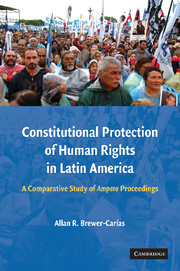 Constitutional Protection of Human Rights in Latin America
Constitutional Protection of Human Rights in Latin America Book contents
- Frontmatter
- Contents
- INTRODUCTION
- PART ONE THE CONSTITUTIONAL AND INTERNATIONAL DECLARATION OF HUMAN RIGHTS AND ITS JUDICIAL GUARANTIES
- PART TWO THE AMPARO AS A LATIN AMERICAN CONSTITUTIONAL AND INTERNATIONAL LAW INSTITUTION
- PART THREE THE INJURED PARTY AND THE CONSTITUTIONAL RIGHTS PROTECTED BY MEANS OF THE AMPARO PROCEEDING
- Chapter Nine The Injured Party: The Plaintiff and the Rules of Standing
- Chapter Ten The Justiciable Constitutional Rights by Means of the Amparo and Habeas Corpus Actions
- Chapter Eleven The Question of the Justiciability of Social Constitutional Rights by Means of the Amparo Actions
- PART FOUR THE INJURY, THE INJURING PARTY AND THE INJURING ACTS OR OMISSIONS IN THE AMPARO PROCEEDING
- PART FIVE THE EXTRAORDINARY CHARACTER OF THE AMPARO PROCEEDING
- CONCLUSION
- APPENDIX A List of Latin American Constitutions
- APPENDIX B List of Latin American Amparo Laws (Statutes)
- INDEX
Chapter Nine - The Injured Party: The Plaintiff and the Rules of Standing
Published online by Cambridge University Press: 08 August 2009
- Frontmatter
- Contents
- INTRODUCTION
- PART ONE THE CONSTITUTIONAL AND INTERNATIONAL DECLARATION OF HUMAN RIGHTS AND ITS JUDICIAL GUARANTIES
- PART TWO THE AMPARO AS A LATIN AMERICAN CONSTITUTIONAL AND INTERNATIONAL LAW INSTITUTION
- PART THREE THE INJURED PARTY AND THE CONSTITUTIONAL RIGHTS PROTECTED BY MEANS OF THE AMPARO PROCEEDING
- Chapter Nine The Injured Party: The Plaintiff and the Rules of Standing
- Chapter Ten The Justiciable Constitutional Rights by Means of the Amparo and Habeas Corpus Actions
- Chapter Eleven The Question of the Justiciability of Social Constitutional Rights by Means of the Amparo Actions
- PART FOUR THE INJURY, THE INJURING PARTY AND THE INJURING ACTS OR OMISSIONS IN THE AMPARO PROCEEDING
- PART FIVE THE EXTRAORDINARY CHARACTER OF THE AMPARO PROCEEDING
- CONCLUSION
- APPENDIX A List of Latin American Constitutions
- APPENDIX B List of Latin American Amparo Laws (Statutes)
- INDEX
Summary
The injured party, that is, the claimant, also called the complainant, the petitioner or the plaintiff, in principle is the person having the constitutional right that has been violated; a situation that gives him a particular interest in bringing the case before a court. That is why the amparo action has been considered as an action in personam through which, seeking for the protection of constitutional rights, the plaintiff must be precisely the injured or aggrieved person.
That is why it is generally considered that the Latin American amparo action, in the same sense as the action for injunction in the United States, needs to be personalized, in the sense of being attributed to a particular person that because enjoying the harmed right, has a justiciable interest in the subject matter of the litigation, or a personal interest in the outcome of the controversy.
It is in this sense that the Nicaraguan Amparo Law provides that only the aggrieved party can file the amparo action, defining as such, “any natural or artificial person whose constitutional rights are harmed or that are in a situation of imminent danger of being harmed by any disposition, act or resolution, and in general, by any action or omission from any public officer, authority or its agent” (Article 23).
- Type
- Chapter
- Information
- Constitutional Protection of Human Rights in Latin AmericaA Comparative Study of Amparo Proceedings, pp. 181 - 211Publisher: Cambridge University PressPrint publication year: 2008


